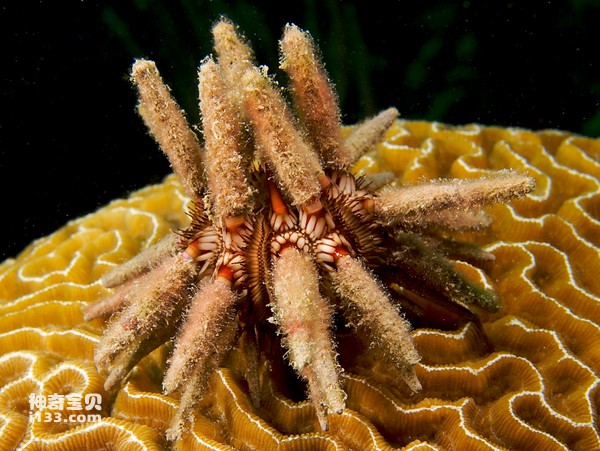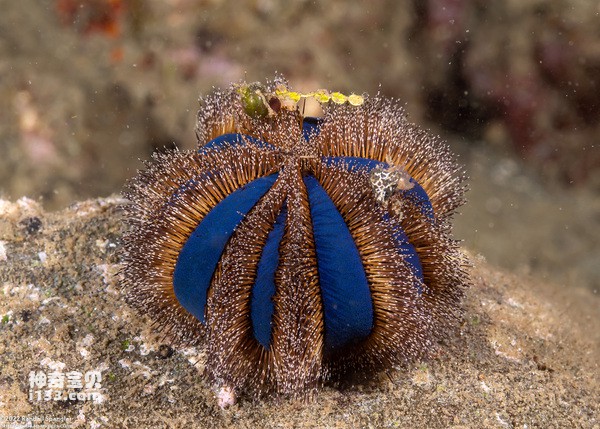Sea urchins are invertebrates that live in shallow waters of the ocean, and many species of these ancient creatures are edible to humans. However, some sea urchins that look particularly fresh and beautiful are often poisonous. Do you know which species of sea urchins look the prettiest? Here we introduce to you the ten most fascinating species of sea urchins, including trumpet thorn sea urchin, flame sea urchin, slate pencil sea urchin, blue dress sea urchin, giant purple ball sea urchin, spiny sea urchin, star anal sea urchin, etc. Let us appreciate their beauty together!

1. Trumpet thorn sea urchin
The trumpet thorn sea urchin looks like a colorful trumpet flower and is recognized as one of the most beautiful sea urchins in the world. Its habitat is mainly distributed in tropical seas. Different from common edible sea urchins, trumpet poisonous sea urchins are highly poisonous. Their venom glands are highly developed and extremely toxic. Once stabbed by it, the pain may be unbearable in mild cases, or even life-threatening in severe cases. Therefore, people should stay away from them and not touch them at will. In 2014, the sea urchin was listed as the "most dangerous sea urchin" by Guinness World Records. Perhaps their bright colors are just a warning signal to potential predators.

2. Flame sea urchin
Which species of sea urchin is the most beautiful? I personally tend to choose flame sea urchins because of their fiery red body and unusually long and slender spines. Although the flame urchin's name suggests that it may burst into flames, it actually gets its name not because it actually ignites, but because of the red and white spikes on its exterior that are highly toxic. Once in contact, it will cause a burning and painful sensation. In addition, the appearance of the flame urchin is indeed reminiscent of the flames burning on the seabed, which is extremely colorful and charming. The flame sea urchin has become a striking "protector" on the seabed with its unique self-protection mechanism. Many small seabed animals, such as crabs, shrimps and lionfish, will hide around the flame sea urchin to avoid predators.

3. Stone pen sea urchin
The stone pencil sea urchin is recognized as one of the most ornamental sea urchins and presents a beautiful appearance when alive. The body color of this kind of sea urchin is usually uneven light brown or grayish brown, sometimes with gray or black purple markings. The end of the large spine often shows 1-3 light-colored rings, and the end of the large spine on the oral surface It often appears red. The medium-sized spines may be white, brown, or purple-black. Slate sea urchins usually inhabit coral reef caves along the coast, and are sometimes found in water depths up to 20 meters. They mainly lay eggs in April every year and are mainly distributed in coastal areas such as Hainan, Xisha and Nansha in China.

4. Blue Dress Sea Urchin
Which species of sea urchins are suitable for farming? I highly recommend the blue dress sea urchin, which is distributed in the Indian Ocean, the Pacific Ocean, and extends to the South my country Sea and the southern waters of Japan. There are 5-10 broad veins on the body of the blue dress sea urchin, which are often blue or black, while the spines are red, brown or black. Its appearance is strange and elegant, and when it walks, it stretches out many tentacles to explore its path. In addition, the blue dress sea urchin is also an excellent ocean tank scavenger, good at removing algae, and has the characteristics of both ornamental and practical use.

5. Giant purple ball sea urchin
Among the varieties of sea urchins, the famous giant purple ball sea urchin cannot be ignored. This kind of sea urchin is mainly found in coastal shallow waters of the Pacific Ocean and other marine environments. The characteristic of the giant purple ball sea urchin is that its bold shell is spherical, showing a five-spoke symmetrical structure, with two rows of walking plates and two rows of stepping plates alternately arranged, and it also has Aristotle's lantern. Its bile shell is approximately 25 cm in diameter. Body color ranges widely and may appear in shades from red, reddish-brown, brick red, burgundy to deep purple. The giant purple ball sea urchin relies on the spikes on its body to protect itself from harm.

6. Long-spined sea urchin
The long-spined sea urchin, also nicknamed the "devil sea urchin", is widely distributed in the Indian Ocean and the Western Pacific. This is a large sea urchin with an inner shell that can exceed 10 centimeters in diameter. The entire body is black with a red eyespot in the center, and the length of the black spines can reach more than 15 cm. These spines are venomous and easily broken. Once stung, the pain is comparable to a bee sting. Although spiny sea urchins may look slender, they are good at protecting themselves and can coexist with aggressive fish, controlling excessive algae growth.

7. Star-anal sea urchin
The star anal sea urchin is also one of the famous species in the list of sea urchin species. The characteristics of this kind of sea urchin are that the eye plates are arranged around the anus, forming a circle of anal plates, and the central part is membranous and exposed; the anus is located on a low cone-shaped protrusion; the large spines are slender and hollow, curved, and the length About 3-4 cm, with longitudinal grooves and spirally arranged slender spines on the surface. The exposed band around the anus and its branches are dark red, forming a beautiful star-shaped pattern, while the outside of this area is gray-brown or gray-purple, which is one of the important characteristics of this sea urchin.

8. Crown-thorn sea urchin
The sea urchin crown-thorn is widely distributed from the Indian Ocean to the western Pacific. This kind of sea urchin has a larger circumference and wider and more obvious gill slits. The large spines on the walking belt do not form rings, but there are slender longitudinal grooves on the surface. The large spines or poisonous spines on the walking belt are very short and thin. Long needle-like with a barb at the top. During the growth period, the spines and shells of the crown-thorn sea urchin are black-purple, and some individuals may be yellow-green with dark rings; the spines on the walking band are yellow. The surface of the spines of young individuals is darker, the spines on the anti-mouth surface are not green, and the surface of the shell is almost white.

9. Spotted mushroom and sea urchin
The spotted mushroom sea urchin is a species of sea urchin with a very charming appearance. It is large, oval in shape, and covered with countless spines of basically the same length. The overall appearance is colorful and furry, and some even look very cute. Their colors are usually a mixture of red, white and blue, creating colorful patterns. These sea urchins need enough hiding places and space to find food. They usually hide in caves during the day and build nests in the thick sand bottom. The spotted mushroom sea urchin is usually solitary, but can tolerate the presence of others of its own species. However, they are less tolerant to high nitrate and copper ions and will shed their thorns when water quality deteriorates.

10. Red sea urchin
Red sea urchins often feature in various sea urchin inventories and are sometimes called "red sea urchins." Although they all appear red in appearance, they vary in color from brick red to burgundy. These urchins have relatively short spines and tend to stay on sheltered rocks, while their gonads are yellow in color.
People are familiar with red sea urchins not only for their delicious taste, but also for their longevity properties. Among the top ten longest-lived animals on earth, the red sea urchin ranks fourth with a lifespan of up to 200 years.
The list of the top ten most beautiful sea urchins is mainly based on the animal's appearance evaluation/famousness, and comprehensive reference to relevant Internet rankings/lists for recommendations. If you have any questions, please leave comments/criticisms at the end.
animal tags: Echinoidea
We created this article in conjunction with AI technology, then made sure it was fact-checked and edited by a Animals Top editor.